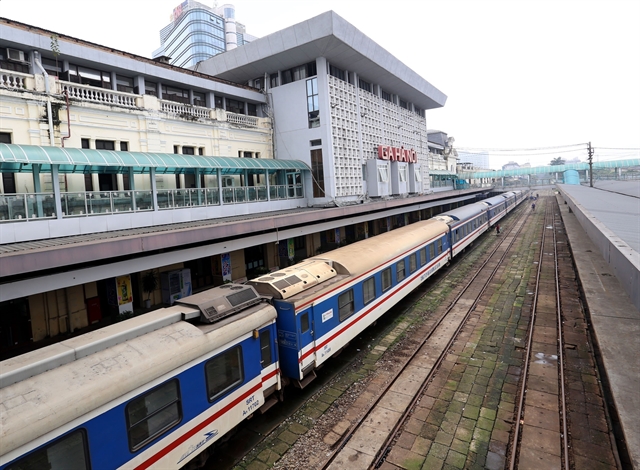 Society
Society


|
| A train about to leave the Hà Nội Railway Station. VNA/VNS Photo Huy Hùng |
HÀ NỘI – The north-south high-speed railway project, the largest of its kind in Việt Nam in both funding and technological complexity, has attracted considerable attention and resulted in diverse perspectives from various management agencies.
Most management agencies have emphasised the necessity for thorough consideration and assessment of the impact associated with each investment option for the project.
The Party Central Committee's Conclusion No 49-KL/TW issued on February 28, 2023, regarding the direction of development of Việt Nam's railway transport by 2030, with a vision to 2045, aims to build the national railway infrastructure, and urban railways.
Specifically, the north-south high-speed railway is identified as the "backbone" axis that will connect urban railways, major economic centres, domestic transportation hubs, and international borders.
Recently, the Ministry of Transport sought opinions from experts, scientists, and relevant ministries on the draft plan with three investment scenarios for the north-south high-speed railway project.
Scenario 1 involves building a new double-track railway with a gauge of 1,435mm, a speed of 350kph, exclusively for passenger trains, and upgrading the existing North-South railway line for freight transport. The total investment for the project is US$67.32 billion.
Scenario 2 proposes constructing a new double-track railway with a gauge of 1,435mm, a speed of 250kph, combining both freight and passenger trains. The total investment for the project is $72.02 billion.
Scenario 3 suggests building a new double-track railway with a gauge of 1,435mm, a speed of 350kph, focusing on passenger trains and having provision for freight transport when needed. The existing railway line would be upgraded to specialise in freight and short-distance passenger transport. The total investment for the project is $68.98 billion. The amount will be around $72 billion, including upgrading the existing North-South railway line to the freight train.
The Ministry of Transport has prioritised proposing Scenario 3.
After the information surfaced, most ministries and organisations agreed that railways are lagging behind due to outdated technical infrastructure and declining market share. Therefore, the Party and the State's decision to invest in modern railway lines is appropriate and essential.
However, the choice of scenarios to ensure investment efficiency and suitability for the country's socio-economic situation must be considered carefully.
The Ministry of Planning and Investment stated that Scenario 3 is irrational as it has a design speed of 350kph but a lower total investment than Scenario 2 with a design speed of 250kph.
It also pointed out the absence of content related to freight transportation and internal rate of return calculation in the project.
While agreeing with Scenario 3, the Ministry of Construction noted that the north-south high-speed railway project passes 20 cities and provinces. Currently, these localities are in the process of formulating and approving regional and provincial planning.
The increasing urbanisation process may require changes in the design direction of the high-speed railway. This could lead to adjustments in the project's scope and changes in the total investment.
The Ministry of Construction suggested close coordination between the Ministry of Transport and the 20 localities to ensure the design direction of the project.
The Vietnam Union of Science and Technology Associations stated that it has organised a workshop to gather opinions on the draft plan for the project. After analysis and assessment, some experts and scientists concluded that Scenario 3 is not feasible due to technical factors.
The draft plan is still in the process of collecting opinions.
Many experts emphasised that the technical feasibility and the ability to anticipate shortcomings or unforeseen factors must be considered to avoid repeating the issues of capital escalation, cost overrun, and project delays.
In Việt Nam, many investment projects have experienced prolonged durations and increased capital requirements, primarily due to inadequate research. The Cát Linh – Hà Đông urban railway project was initially approved with a total investment of $552.86 million, and then raised to $868 million. One of the main reasons for the capital escalation was the project's scheduled operation in 2015, which had to be adjusted multiple times, eventually put into operation in 2021.
Similarly, the Nhổn – Hà Nội Station urban railway project was originally planned for commercial operation by the end of 2018 but has not yet finalised its operation date. This project has also proposed a capital adjustment to nearly VNĐ33 trillion, an increase of over VNĐ14.5 trillion compared to the initially approved total.
The Yên Viên – Ngọc Hồi urban railway project should have been implemented since 2012 but still has many items only existing on paper.
During the meeting on the high-speed railway investment project on December 1, Deputy Prime Minister Trần Hồng Hà requested a thorough analysis and evaluation of the overall impact and effectiveness of the high-speed railway on the economy for each scenario regarding speed, combining passenger and freight transportation, upgrading, and utilising existing railway lines.
He emphasised the need to optimise the operational capacity of different transportation methods and ecosystems.
Hà said that investing in high-speed railways is a long-term investment for the future, which should set the overall goal of forming an industry with the capability to master technology, ensuring the safe, efficient, and sustainable operation of high-speed railway lines within the transportation ecosystem. VNS